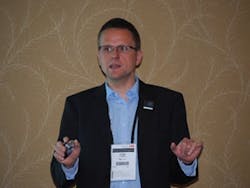The Power of Integration
ABB is bullish on the potential for integration to help industry and society achieve new levels of efficiency and sustainability, according to Peter Terwiesch, ABB CTO, who addressed a gathering of media press this week at ABB Automation and Power World 2010 in Houston.
He began with a discussion of the integration of renewable power sources into tomorrow's smart grid, enabling the power distribution systems to host and compensate for disparate sources such as wind, solar and others.
Power generation creates 41% of overall emissions, and there are large transmission losses from step-down transformers and lower-voltage transmission lines. Since electricity consumption is growing at about twice the rate of overall energy demand, especially in developing areas such as China, it is becoming more important to look to alternate energy sources, Terwiesch noted.
"Renewables," he said, "are a fast-growing market opportunity." He showed some dramatic curves indicating that wind power is growing at upward of 17% CAGR, while solar, including photovoltaics, is growing at twice that rate. Wind opportunities are pretty evenly split between Europe, Asia and North America, he noted. So ABB has been concentrating on the building blocks, such as the company's new solar power inverter, to make it easy to integrate alternate energy sources into the grid. It is this kind of device that will make the grid capable of accepting variable sources of energy, Terwiesch said.
In China, hydropower rules. China's hydropower resources are chiefly in the west, while the population and the majority of electrical consumption is in the east. It is not uncommon to have transmission distances of 2,000 to 3,000 km, such as those on the Xiangjiaba-to-Shanghai transmission line, which carries "more than the average consumption of Switzerland, where I live," Terwiesch said.
In the developed countries, it is wind that is the largest potential for non-fossil growth. He described the BorWin I project in Germany, which is, like many of the wind-farm projects in Europe, offshore in the North Sea. "We can take care of the NIMBY effect that way," Terwiesch said, "because you can't see the windmills out there."
But the BorWin I project required 200 km of undersea and underground cables to provide the 400-MW capacity of the project to a point in the grid robust enough to take the power. ABB had to develop a new, oil-free HVDC cable for projects like these. This is the cable that Enrique Santacana, president and CEO of ABB Inc. and region manager for North America, announced would be made in a new $90-million plant to be erected in the United States that is expected to be in operation by 2012.
The so-called "smart grid" is more than moving bits and bytes, he added. It is also about moving electrons. "We are going to see a widened grid," he said as he showed an animated slide adding islanding, voltage and load control, SVC and storage components, fault current limitation and demand-response. He described a real-world, very large-scale demo at the Stockholm Royal Seaport that includes smart homes and buildings, distributed energy systems, integrated use of electric vehicles, energy storage for network support, shore-to-ship solutions ("so the big cruise liners don't have to keep running their engines while in port," Terwiesch noted), smart primary substations and a smart grid laboratory, part of the larger Stockholm Royal Seaport Laboratory. "The Seaport's goal," according to Terwiesch, "is to be fossil-free by 2030." Terwiesch also described the Boulder, Colo., integration project done by ABB's new acquisition, Ventyx, that integrates alternate energy sources using four SVCs.
"If I could be visionary for a moment," Terwiesch said, "I would be looking for a DC overlay grid that would operate in addition to, rather than replacing the existing AC grid. But back in the here-and-now, motors and drives are the greatest energy efficiency opportunity we have." He described the new ACS2000 medium-voltage drive, which is transformerless to 6.9 KV. "Size reduction matters," he said, in describing the evolution of the ACS800 small-footprint drive to the ACS850 even-smaller-footprint drive.
ABB is unique, Terwiesch said, in being able to provide power electronics devices, assemblies and applications. This unified approach to protection and control is good for productivity, which logically brought him to the convergence of power controls and process controls in the System 800xA. He pointed out that this combined control system provides a plant-wide sequence-of-events (SOE) recorder for the very first time. Based on open standards, the combined system is an idea whose time has come, he said. "'But when?' you ask, and I say 'now.'" He listed 23 projects in a variety of industry verticals such as oil & gas, power gen, and mining and minerals—none, however, in North America.
Next, Terwiesch turned to new features in both software and products. He described a major new feature in 800xA v.5.1―node virtualization. This makes it possible to eliminate the proliferation of servers that used to be required in favor of a very small number of redundant servers. "It is easier to upgrade the servers this way, too," he said.
In terms of new products, he pointed to ABB's Optical Caliper―a non-contact thickness gauge for paper on a web machine, and the FieldKey WirelessHART adapter.
"BASF and NAMUR tested it and found it and WirelessHART to work quite well. But one thing we've learned is that most customers don't like the idea of having to change perhaps thousands of batteries every five years or so."
Terwiesch closed with some predictions for the future of wireless field devices. "We are entering the age of the autonomous field device," he said. "It will be powered by wind, solar, thermal gradient and power harvested from vibration. And we can do it now. In the show display area there is an autonomous temperature transmitter, WirelessHART-enabled, deriving its power from the thermal gradient from the thermowell. Go see it."



